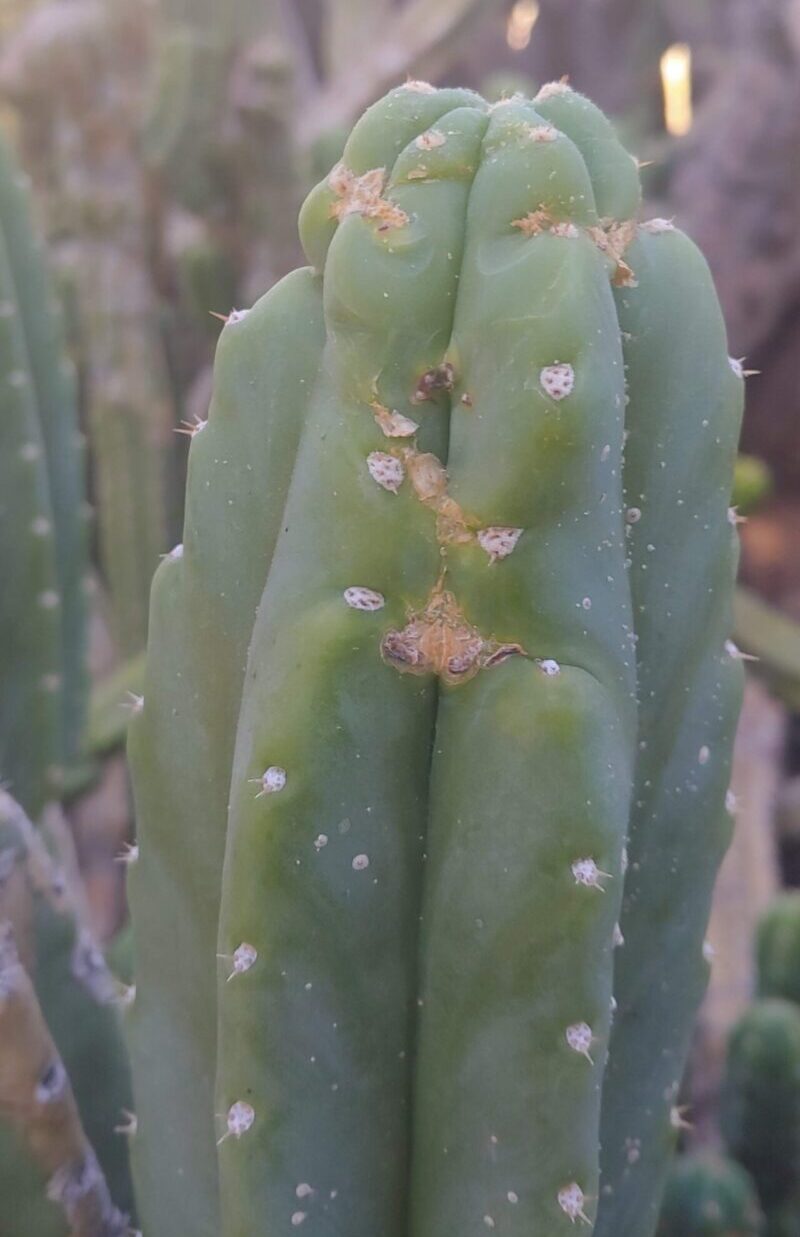Don’t buy any pesticides without reading this first!
Many formulas at big box stores use harmful chemicals that will burn your cacti and poison wildlife!
Often the simplest answer is the best, we like to remove as many bugs as possible by hand,
using pliers for slugs and snails or spraying plain water to deter whiteflies.
Even simply scrubbing clinging bugs like scale loose with an old toothbrush will do the trick in most cases.
Rather than using pesticide for control we protect plants through ecologically friendly nutrients and specific biopesticides that have shown to be minimally harmful to wildlife.
these methods provide a higher level of protection from insects, pathogens, and soil-borne diseases, without disrupting the local ecology!
but let me go ahead and run down some common organic pesticide options that come with possibly unknown consequences that you have to keep in mind first.
We don’t use Pyrethrin because it’s especially toxic to fish and bees.
Some people say Pyrethrin and other synthetic versions are great natural alternatives to toxic pesticides because they’re made from plants and have a short half life.
It’s still toxic to bees , fish and cats, so it’s only useful in controlled environments away from susceptible animals.
If you spray pesticide formulas including any type of soap on your cacti it could strip their waxy coating leaving them exposed to black blistering and sunburn.
Be very careful if you decide to use Pyrethrin. Don’t allow skin exposure or apply without a mask to protect your health!
Neem is less toxic for broad control, but still, take precautions.
Neem is also toxic to bees so don’t apply during bloom formation. it’s definitely a lot less harmful than Pyrethrin when it comes to possible runoff’s effect on fish, yet still… quite a concern.
Neem formulas using soap can cause killer sunburn on your plants when applied as a spray, so wait until it’s night.
Neem meal can be used in the soil preventatively on a bi-monthly to monthly basis as control for mites, scale and many other common pests.
We don’t want to bother with possible negative effects on our local ecosystem, so we instead use the following…
Diatomaceous Earth protects against bugs, beefs up plants AND doesn’t impact bees or fish negatively!
Diatomaceous earth aka DE is a great pesticide for stopping the spread of slugs, scale, mealybugs and and other crawling or soil borne pests, but it’s also a great source of silica, calcium and various micronutrients which promotes secondary growth (thickness) and immunity to diseases from pests especially in our San Pedro cacti. It’s a win-win for minimizing bug damage!
Considered safe for fish and bees, as well as food safe for humans, DE is one of my overall favorites!
It works best spread as a ring around your plant into the soil or dusted onto the stems of your cactus effected by pest as well as nearby plants.
You can apply it at a rate of 4 to 6 tablespoons per gallon and then spray it onto your plants, as well. However, it will only work once it’s dried out after application, so this may not be the best option for immediate control, and may be more suited to preventative action or to absorb more benefit from the nutrient content of DE.
Chitosan enhances your plant’s natural defenses against damage from sun, pests, fungus & bacteria by increasing nutrient absorption and production of defense chemicals!
Chitosan improves photosynthesis, resistance to salty soils, root resistance to pathogenic nematodes, and is generally amazing for plant health especially following pest attacks.
used to improve bee health in commercial beekeeping and in human dietary supplements, chitosan is the opposite of the first two pesticides I listed when it comes to safety for bees, fish, humans and pets. And what’s why we use it!
applying purified Chitosan foliar feed during the daytime can cause killer sunburn. it’s best applied at night or in the soil.
chitosan rich soil amendments such as crushed crab/urchin shells or insect frass should be applied at least once every other month during the growing season, or a spray of diluted (.3g per gal) pure chitosan after bug damage aides in repairing and immunizing the plant against bacterial & viral infections that could have been transferred by pests. However, we prefer to use natural sources rather than extracts. “purity” isn’t as good as a well-rounded fertilizer that can enrich your soil with micronutrients at the same time!
Bacillus Thuringiensis (Bt) only kills specific target pests & is safe for bees + pets!
- Bt israelensis controls immature larvae of mosquitos, flies, and gnats
- Bt aizawai and Bt kurstaki control caterpillars of moths and butterflies.
- Bt tenebrionis and Bt japonensis control beetle larvae.
- Bt san diego controls beetle larvae
Bacillus Thuringiensis is a group of commonly used biopesticides that target harmful pests by disrupting their digestive system without any adverse effect to humans, pets, aquatic or beneficial pollinator wildlife.
Bt is Best applied at night just like the first two entrants, but not to decrease sun burn.
Bt degrades VERY fast in light. It’s one of the most environmentally friendly biopesticides in both its production and use!
BT also provides protection against viruses often carried by bug damage which makes it one of our overall favorites for targeted pest protection!
You should check your plants nutrients and soil if it has frequent bug problems.
Reoccurring bug damage may mean that your plant’s ability to fend off predators and grow healthily is compromised.
over-fertilizing plants can actually increase pest problems just as under-fertilizing has been known to.
Research has shown increasing nitrogen levels too high can decrease your plant’s resistance to pests!
A healthy supply of calcium, sulfur, potassium and phosphorus reduces the likelihood of insect attacks, re-potting can potentially help with insect problems as well.
Good luck, and may your garden be not only beautiful, but beneficial to the local wildlife!
